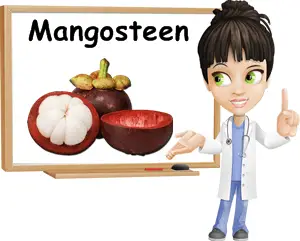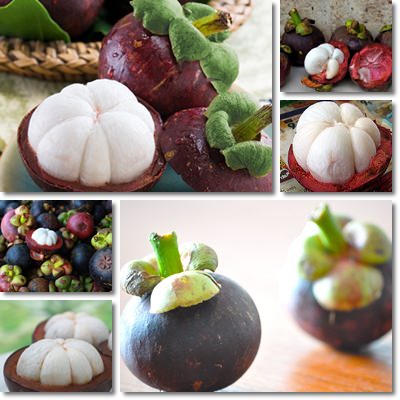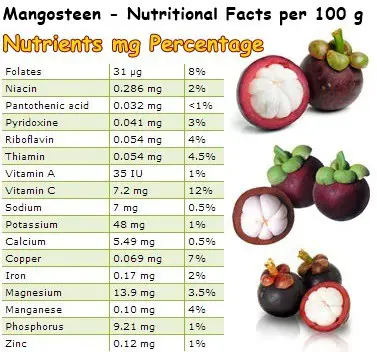The fruit of the mangosteen tree (Garcinia mangostana) is commonly referred to as the purple mangosteen or simply mangosteen. Native to Southeast Asia, mangosteen trees love sunny weather and tropical climates and, for this reason, they are impossible to find outside tropical areas. The fruit is extremely popular in many Asian and South American countries, notably Thailand, parts of India, Puerto Rico, the Dominican Republic or Colombia. However, due to not meeting specific quality regulations, it is scarce in US or Europe markets.
What does purple mangosteen fruit look like?
The mangosteen is a precious-looking, red-purple round fruit with a sort of a green cap. Unripe mangosteen fruit have a light green hard rind. As the fruit matures, the rind turns a beautiful deep red-purple and softens only when it is ready to be consumed. The edible part is a white, segmented, tangerine-sized pulp with a few seeds the size of prune seeds hidden within.

What does mangosteen taste like?
The pulp of the fruit is divided into 4-8 creamy-white, wedge-shaped segments, similar to citrus fruit. Mangosteen is said to have a mildly sweet, yet slightly unpleasant taste according to some. The ripe pulp is soft, almost banana-like and the fruit’s aroma is reminiscent of lychee, melon, pear and banana, but with a unique taste. You either like it or you don’t, depending on taste preference. It is in season roughly from June till October. When available in some Western markets, fresh mangosteen is rather pricey: up to 40-50$ per pound.
Mangosteen nutrition facts and benefits
Considering its scarcity in both European and US markets, mangosteen has been given little attention by the scientific community compared to other foods. However, we can tell from the little amount of data available, that the purple mangosteen has an average nutritional content and can be situated roughly at the same level with apples, as you can see from the table below.
Nevertheless, the purple mangosteen is rich in antioxidant compounds and thus boasts several rather impressive health benefits. Mangosteen juice is especially healthy. Not only does it concentrate 4-5 times the nutritional content of the fruit pulp in one serving, but it also contains crushed peel. Purple mangosteen peel is highly efficient in reducing C-reactive protein blood levels. C-reactive protein is a biomarker indicating inflammation levels; high levels of this protein have been linked to diabetes, cancer and cardiovascular disease.

Mangosteen is said to be highly protective of cardiovascular health in particular by promoting the dilation of blood vessels. Regular consumption of the fruit ensures a good blood flow and thus protects against atherosclerosis. The peel of the fruit is a rich source of more than 40 natural antioxidants known as xanthones, the most potent of which are alpha-mangostin and gamma-mangostin.
The xanthones in mangosteen have strong healing and anti-inflammatory properties. Basically, eating the pulp or drinking the juice of the fruit protects from cardiovascular disease, slows down the aging process and helps regenerate cells following damage from free radicals. Foods with anti-inflammatory properties also provide benefits such as pain relief, contributing to improved symptoms in inflammatory conditions such as arthritis.
Alpha-mangostin in the purple mangosteen fruit is such a strong antioxidant that it can prevent tumor growth, provided the fruit is consumed regularly. Also, it amplifies antibiotics action and provides protection against the tuberculosis pathogen, Mycobacterium tuberculosis. In addition to this, it has been shown to be a powerful ally in the fight against allergies.

Gamma-mangostin from the purple mangosteen fruit is said to be a more powerful antioxidant than vitamin E. Gamma-mangostin reduces inflammation and helps lower LDL cholesterol levels, thus reducing cardiovascular disease risks. Most important, heart medication based on this antioxidant compound found in the fruit is said to be very gentle on the stomach, unlike regular medication which can lead to gastritis or ulcer. Also, regular consumption of purple magosteen is said to alleviate asthma and allergy symptoms as a result of the gamma-mangostin content of the fruit.
Because it is low in calories (63 kcal/100 g of pulp) and contains no saturated fats or cholesterol mangosteen makes a great dessert option if you are looking to keep a steady weight. It is recommended for people suffering from cardiovascular disease because it does not contribute to a high cholesterol profile or artery damage. The fruit also boasts a good vitamin C content: 12% of the RDI, recommended daily intake.
In traditional medicine, purple mangosteen rind is used to treat dysentery, diarrhea, urinary infections as well as eczema or gum problems. Overall, all of these health benefits are a result of the fruit being an incredibly rich source of potent antioxidants which protect against free radical damage, reduce inflammation levels in the body, hold cardiovascular benefits and exert a strong antimicrobial action.
